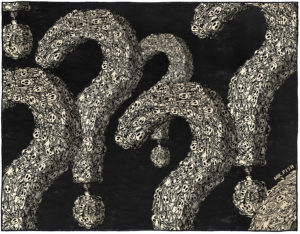Sarajevo 1914 / Gaza 2014: The Short Twentieth Century Lingers On
Strange the way things line up, the through-lines that suddenly reveal themselves amidst the twists and turns of historical progression. A Palestinian looks for his belongings after a house was destroyed in an Israeli strike in Rafah in the southern Gaza Strip on Saturday. AP/Hatem Ali
A Palestinian looks for his belongings after a house was destroyed in an Israeli strike in Rafah in the southern Gaza Strip on Saturday. AP/Hatem Ali
Strange the way things line up, the through-lines that suddenly reveal themselves amidst the twists and turns of historical progression.
Last month, in these pages, I was writing about the ways in which Israel’s ongoing treatment of Gaza and the Palestinians cooped up therein (the strangulating siege, the warehoused concentration-camp-like conditions, the regularly recurrent assaults, the lopsided carnage) put me in mind, not so much of the fate of the Jews and gays and Gypsies in Dachau or the Warsaw Ghetto in the years before the Final Solution, or the Afrikaners under the British during the Boer War, or the Sowetans under apartheid, or the Japanese-Americans in their World War II internment camps (all analogies regularly invoked both by me and others), as that faced by the citizens of Sarajevo during the terrible 1,500 days of their siege and bombardment by the Bosnia Serbs from 1992 through 1995. And then furthermore, come to have thought of it, how uncannily the obfuscations and protestations and delusionally heightened sense of grievance regularly expressed by many Israelis (and even more of their American apologists) reminded me of the sorts of “bugs in the software,” the “brain damage,” the raving, raging momentary episodes of slippage I’d so frequently encountered among otherwise quite sensible and civilized Serbians in Belgrade during that same period just after the recent Bosnian War.
Some people liked the analogy, others didn’t, but in the meantime I myself, this past week, have found myself falling clear through that historical parallel and down through the years to that other, or rather that earlier Sarajevo, the site in 1914 of the assassination of the Archduke Ferdinand and his wife by the Serb nationalist fanatic Gavrilo Princip. One hundred years ago June 28, the event set the gears in seemingly inexorable motion toward the launch of actual hostilities exactly one hundred years ago this week as World War I brought a horrendous Niagara-like (Henry James’ image) conclusion to the nearly 100 years of relative peace on the European continent since the aftermath of the Battle of Waterloo in June of 1815, and, in turn, launched the harrowing succession of decades that were to follow, dark-blasting so much of the rest of the 20th century.
More specifically, I’ve been thinking about the way historians over the last few decades have regularly taken to speaking of the Long 19th Century (by which they mean the years from the French Revolution of 1789 through the start of the First World War in 1914) and the Short 20th Century (from 1914 through the remarkable succession of largely nonviolent revolutions that brought about the downfall of communism in 1989). That 1789/1989 rhyme is indeed remarkably uncanny, but no less so the way that so many of the historical processes set in motion in 1914 did indeed seem, finally, to resolve themselves in 1989. The braiding in particular of the rise and fall of the twin totalitarian scourges launched by the catastrophes of that First World War: the way Bolshevism was able to overthrow the ages-old Imperial order in Russia in 1917 as a direct result of the latter’s calamitous failures on the Eastern Front, but also the way that the rise of Nazism proved a direct result (directly predicted at the time) of the way Germany was mistreated in the grievously misguided peace settlements after 1918. How the inevitability of a Second World War was almost baked into the mix at Versailles, one that would come to pit Bolshevik Russia (and her allies) against Nazi Germany, calving off large swaths of Central and Eastern Europe in the peace that followed and subjecting them to Soviet Russian domination for almost another half-century, that is until successive uprisings in that same (as it turned out, indigestible) periphery came to bring about the downfall of communism in Moscow Central itself, thereby reuniting a transformed and now decidedly more pacific Germany at the heart of a decidedly wiser and more tempered United Europe. Problem solved, Short Century closed.
Except that, it seems to me, it’s becoming more and more clear that that standard account leaves something important out, and that the intricate braidings of the so-called Short Century have in fact yet to play themselves through.
Leave aside such peripheral (albeit paradoxically seminal) problems as what to do with those damn Balkans. (Sarajevo! The place it all started.)
Turn instead to what in retrospect may have proved a whole other strand of historical braiding across the Short Century: the question of what to do with Europe’s Jews.
Granted, the taproots of that dilemma wend well back into the Long Century, generally speaking to the upsurge in anti-Semitism occasioned most immediately by the flood-tide of Jewish assimilationism in the wake of the French Revolution, and more specifically to the ways in which that anti-Semitism initially flared most powerfully in France (partly as a result of the French military’s humiliating defeat at the hands of a surging Germany during their mini-war in 1870) with the appalling Dreyfus affair of 1895 and its various unwindings in the years thereafter. That affair (at first, essentially, a German spy scandal at the heart of the French military command) in turn left two lasting legacies, in terms of the history of braidings we are considering here: It badly damaged French military command cohesion and integrity in the decades leading up to 1914, thereby accounting to some degree for the relative incompetence of the French military response to the German invasion in the first months of the coming war; but more to the point, it (along with the rise to power back in his hometown of Vienna of the rabid anti-Semite mayor Karl Luger that same year) inspired Theodor Herzl, an Austrian journalist in Paris to cover the Affair, to publish the following year “Der Judenstaat,” the founding document of Zionism and the entire Zionist movement, with its clarion call for the creation of a national homeland for Europe’s Jews in Palestine. Herzl, who died in 1904, never lived to see the sequence of events that were to play out across the two world wars that dominated the first half of the ensuing Short Century, and that would in turn bring about the realization of his dream. For starters, it’s worth remembering that the Zionist cause received one of its most significant pushes forward as the First World War was nearing its climax with the Balfour Declaration of November 1917, wherein the British foreign secretary affirmed that “His Majesty’s government view with favour the establishment in Palestine of a national home for the Jewish people and will use their best endeavours to facilitate the achievement of this object.” At the time, according to historian James Gelvin, the British foreign office was motivated to issue the Declaration (notwithstanding contravening pledges the Brits appear to have been making at the same time to their Arab allies in the war against the Germans’ Ottoman confederates) in the hopes that supporting Zionist aspirations might in turn shore up support among some of their own other and more significant allies.
The British did not know quite what to make of President Woodrow Wilson and his conviction (before America’s entrance into the war) that the way to end hostilities was for both sides to accept “peace without victory.” Two of Wilson’s closest advisers, Louis Brandeis and Felix Frankfurter, were avid Zionists. How better to shore up an uncertain ally than by endorsing Zionist aims? The British adopted similar thinking when it came to the Russians, who were in the midst of their revolution. Several of the most prominent revolutionaries, including Leon Trotsky, were of Jewish descent. Why not see if they could be persuaded to keep Russia in the war by appealing to their latent Jewishness and giving them another reason to continue the fight?
In the event, of course, the Declaration had little immediate effect, either on the Bolsheviks, who left the war effort nonetheless, or on Wilson, who declined to include a Jewish state as part of the postwar Versailles settlement that enshrined so many other national aspirations, while at the same time shredding the losing German side’s prospects so savagely that many even at the time argued that a second war would now likely prove just about inevitable.
Few even then though could have predicted just how unprecedentedly horrendous the resultant Nazi German regime would prove, or how calamitous for Europe’s Jews. And there is little doubt that following the Second World War (braid into braid, strand upon strand), the case had become well nigh irrefutable that the surviving Jewish remnant indeed finally did deserve a state of its own. But — and here is the crux of the matter, at least in terms of how history thereafter would play out — why not the state of Bavaria, for example, or the Ruhr Valley, or Vienna and its surrounds? All sorts of massive movements and relocations of population were taking place in the years immediately after the war. Wouldn’t a more just settlement of Jewish claims have taken territory from those who had inflicted the most horrific suffering and violence upon them, and who would as a result have had the least justifiable cause for complaint?
The fact of the matter is that Europe — all of Europe — had no appetite for such an outcome. Even after the Holocaust, anti-Semitism was still rampant in the higher counsels of governance across the continent (as it had been, for that matter, throughout the war in the relevant reaches of FDR’s State Department). Far easier to foist the problem onto the Arabs of Palestine. This despite the fact that Palestine had been only one of many possible sites for such a homeland in the early days of Zionism (for many years Uganda, for example, had been given almost equal consideration, and secular Zionism hardly based its claims on any biblical standing), and likewise despite the fact that, all that “People without a Land for a Land without a People” rhetoric notwithstanding, Palestine was already full up with people who had been residing there quite peaceably for centuries (even the Balfour Declaration had acknowledged, in a proviso that has tended to fall out of people’s memories, how it should be “clearly understood that nothing shall be done which may prejudice the civil and religious rights of existing non-Jewish communities in Palestine”).
The point I am trying to make here is that the settlement forced upon the local Arabs of Palestine in the years following the end of the Second World War was in many ways every bit as blatantly unjust and corrosive as that forced upon the Germans at the end of the First World War. (When Palestinians decry it as the last great colonialist land grab, undertaken at a time when colonialism was in fast retreat everywhere else, they have a point — a point albeit aimed at Europe generally even more than at the Jews, though Jews supplanting indigenous olive groves with Northern European pine forests so as to cover up evidence of their own depredations hardly get off scot-free.) And, more to the point, every bit as fraught with ongoing consequence. It is in that sense that the so-called Short 20th Century has yet to play itself out. And this is more than a mere quibble over historiographical taxonomy. Because there was one other braiding strand rising up and out from that history that needs to be considered and layered back in: the way in which predominantly Germanic physicists (a plurality of those Jewish) were cracking the atomic code across those very years of the first half of the Short 20th Century, thereby giving rise to the creation (in exile) of an atom bomb that ended the Second World War and then defined the Cold War that followed, right through 1989, though one whose awful pall persists to this day, in arguably its most fearsome prospect, in the form of the Israeli arsenal. (OK, granted, the Indian/Pakistani stashes and the much, much smaller North Korean one may come in a close second, but those belong to other narratives.)
I say this because of the recurrently rabid (see my first article) temper of so much of what passes for Israeli policy these days with regard to the Palestinians, and the seeming inability of so many Israelis (and their allied apologists abroad) to credit the sheer and ongoing human suffering that those policies bring about or to be able with any accuracy to weigh that suffering in proportion to their own discomforts (see the discussion of brain damage in my second piece). And I’m not saying that those two tendencies would necessarily, by themselves, escalate matters to the level of a potential nuclear strike. Rather it is the way the combination of the two, stretched endlessly into the future, with no countervailing pressures of the sort that perhaps only American leaders might be able to bring to bear (but never, never, never seem like they ever will, hogtied and hobbled as they in turn are by the various domestic Likkudist neocon and Christian evangelical lobbies) — how those two together may well serve to isolate the Israeli state more and more, such that it wedges itself into an ever more feverishly self-righteous and self-pitying corner (its military leadership increasingly drawn from the most self-righteous and self-pitying sectors among the settler activists, its civilian leadership driven to ever more extreme positions by the ever more desperate reactions their policies may in turn provoke among the Palestinians), and then, down the line (especially should things turn grim), who knows what a sufficiently panicked Israeli elite might do, given the availability at hand of those “seventy-five to four hundred nuclear weapons” one keeps hearing about? Seymour Hersh’s so-called Samson Option? (The option, incidentally, the Christian evangelicals are banking on, theirs being a millennial time scape far vaster than any piddling Long or Short Centuries.) Masada?
The point, finally, in this context, is that the perhaps not-so-Short 20th Century, which began exactly a hundred years ago this weekend, won’t truly have wound itself out till the Israeli-Palestinian impasse is resolved, one way or the other.
Let us pray.
Coda
These past several weeks, two poems have kept thrumming through my mind. The first being that middle stanza from W.H. Auden’s meditation “September 1, 1939,” just as Europe was plunging back into war:
Accurate scholarship can br> br>
Unearth the whole offence br> br>
From Luther until now br> br>
That has driven a culture mad, br> br>
Find what occurred at Linz, br> br>
What huge imago made br> br>
A psychopathic god: br> br>
I and the public know br> br>
What all schoolchildren learn, br> br>
Those to whom evil is done br> br>
Do evil in return. br> br>
And the second, the countervailing stanzas out of Seamus Heaney’s “The Cure at Troy,” his rendition of Sophocles’ “Philoctetes,” published in 1991, in direct response, one fancies, to the marvels, all around the world, of the immediately preceding years:
Human beings suffer, br> br>
They torture one another, br> br>
They get hurt and get hard. br> br>
{…}
History says, don’t hope br> br>
On this side of the grave. br> br>
But then, once in a lifetime br> br>
The longed-for tidal wave br> br>
Of justice can rise up, br> br>
And hope and history rhyme. br> br>
So hope for a great sea-change br> br>
On the far side of revenge. br> br>
Believe that further shore br> br>
Is reachable from here. br> br>
Believe in miracle br> br>
And cures and healing wells. br> br>
Call miracle self-healing: br> br>
The utter, self-revealing br> br>
Double-take of feeling. br> br>
If there’s fire on the mountain br> br>
Or lightning and storm br> br>
And a god speaks from the sky br> br>
That means someone is hearing br> br>
The outcry and the birth-cry br> br>
Of new life at its term. br> br>
It means once in a lifetime br> br>
That justice can rise up br> br>
And hope and history rhyme. br> br>
For which is it going to be? I keep thrumming, wondering, back and forth, braiding, layering. Those two poems, and Margaret MacMillan’s final lines of evaluation at the conclusion of her magisterial account of the years leading up to the outbreak of the First World War, “The War That Ended Peace:”
If we want to point fingers from the twenty-first century, we can accuse those who took Europe into war of two things. First, a failure of imagination in not seeing how destructive such a conflict would be, and second, their lack of courage to stand up to those who said there was no choice left but to go to war. There are always choices.
Or, to phrase the same idea just slightly differently (returning to a slightly later moment in that same 1939 poem of Auden’s):
Your support matters…“We must love one another or die.”
Independent journalism is under threat and overshadowed by heavily funded mainstream media.
You can help level the playing field. Become a member.
Your tax-deductible contribution keeps us digging beneath the headlines to give you thought-provoking, investigative reporting and analysis that unearths what's really happening- without compromise.
Give today to support our courageous, independent journalists.






You need to be a supporter to comment.
There are currently no responses to this article.
Be the first to respond.